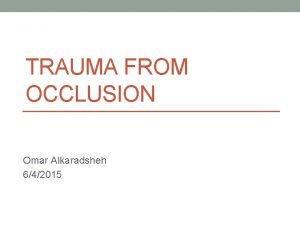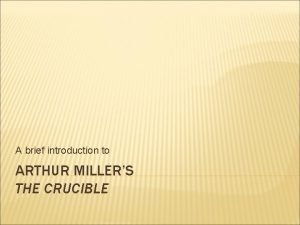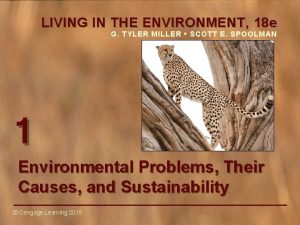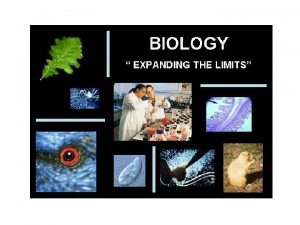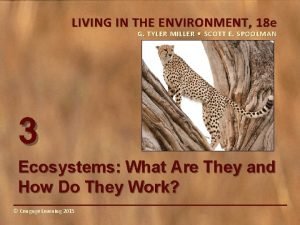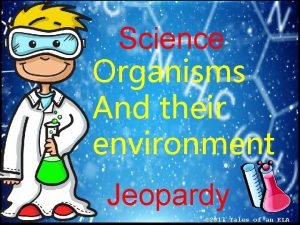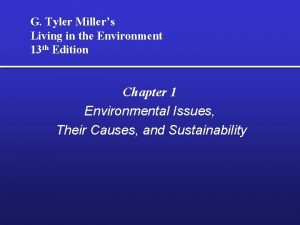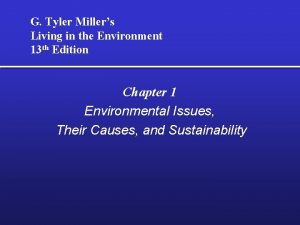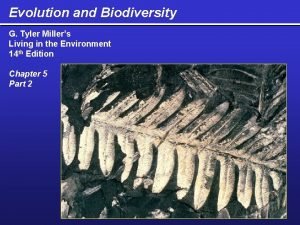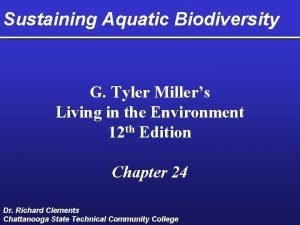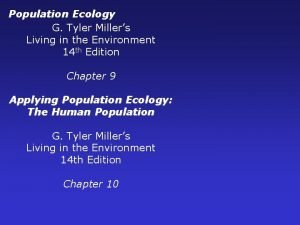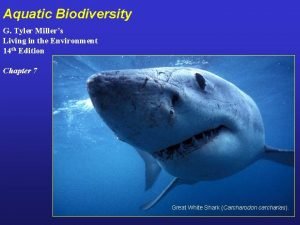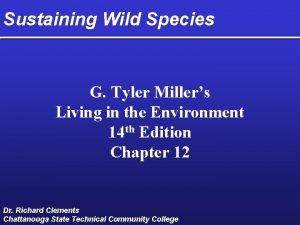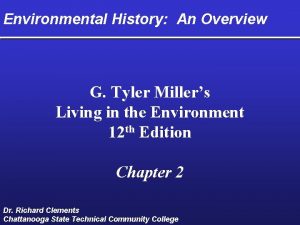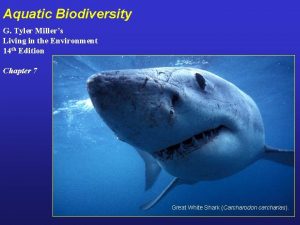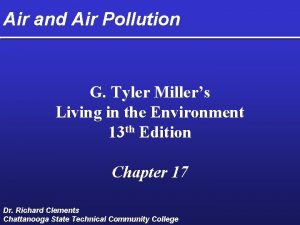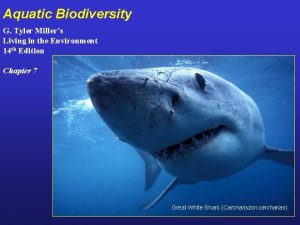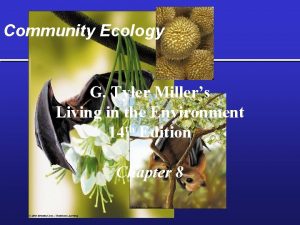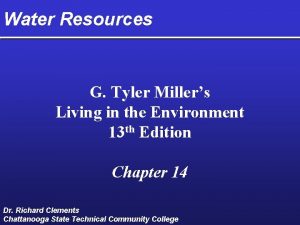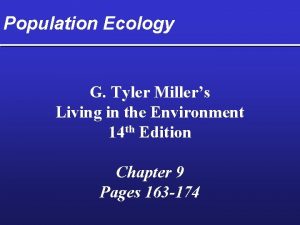G Tyler Millers Living in the Environment 13

















































- Slides: 49

G. Tyler Miller’s Living in the Environment 13 th Edition Evolution and Biodiversity: Origins, Niches, and Adaptations Chapter 5

APES Bell Ringer 11/9/2012 • What is a biome? What do climatograms show us about different biomes? • Biome: A type of large ecosystem with characteristic climate and biota • Climatogram: shows temperature and precipitation patterns

Major Components of the Earth’s Biodiversity

Biodiversity: Who cares?

Which do you like better? A B

Which do you like better? A B

Which do you like better? A B

Which do you like better? A B

Which do you like better? A B

Which do you like better? A B

Which do you like better? A B

What do you think biodiversity means?

Biodiversity What does “Bio” mean? Bio =

Biodiversity What does “Diversity” mean? Diversity = Variety

Biodiversity is the variety of life on Earth and the essential interdependence of all living things • Scientists have identified more than 2 million species. Tens of millions -- remain unknown • The tremendous variety of life on Earth is made possible by complex interactions among all living things including microscopic species like algae and mites.

There are 3 components of biodiversity 1. Diversity of genes Chihuahuas, beagles, and rottweilers are all dogs—but they're not the same because their genes are different. Chihuahua Beagle Rottweilers

There are 3 components of biodiversity Diversity of species For example, monkeys, dragonflies, and meadow beauties are all different species. Saki Monkey Golden Skimmer Meadow Beauty

There are 3 components of biodiversity Variety of ecosystems Prairies, Ponds, and tropical rain forests are all ecosystems. Each one is different, with its own set of species living in it. Paines Prairie Florida Sand hill Pond Hoh Rain Forest

Which is more diverse? A B

Which is more diverse? A B

Which is more diverse? A B

Which is more diverse? A B

Which has more cultural diversity? A B

Which has more biodiversity? A B

Which has more biodiversity? A B

Biodiversity has Intrinsic Value = Something that has value regardless of human uses

Biodiversity also has utilitarian Value Utilitarian Value = value something that has human use Utilitarian values include: • Goods • Services • Information

What do we get from biodiversity? Oxygen Food Clean Water Medicine Aesthetics Ideas

Should we be concerned about biodiversity? What we know: The Earth is losing species at an alarming rate n n Some scientists estimate that as many as 3 species per hour are going extinct and 20, 000 extinctions occur each year. When species of plants and animals go extinct, many other species are affected.

Threats to biodiversity Habitat destruction Pollution Species Introductions Global Climate Change Exploitation

Effects of Humans on Biodiversity • The scientific consensus is that human activities are decreasing the earth’s biodiversity.

What causes biodiversity?

Evolution!!! The change in gene frequencies of a population over time

Origins of Life • Biological evolution – change in the genetic makeup of a population of a species in successive generations – Populations – NOT INDIVIDUALS - evolve Fig. 5 -2 p. 96; Refer to Fig. 5 -4 p. 98

Evolution and Adaptation Theory of Evolution – all species descended from earlier, ancestral species. • Macroevolution - long-term, large-scale evolutionary changes through which • new species are formed from ancestral species and • other species are lost through extinction.

Evolution and Adaptation • Microevolution - small genetic changes that occur in a population. • Gene pool – set of all genes in the individuals of the population of a species • Mutation – changes in the structure or number of DNA molecules in a cell – Mutations are random, rare, only source of totally new alleles • Exposure to mutagens • Mistakes during replication

Mechanisms of Evolution things that cause changes in gene frequencies • • • Mutations Migrations Genetic Drift Natural selection NOT sex

Mechanisms of Evolution Change in genetic material • • • Mutations Migrations Genetic Drift Natural selection NOT sex

Mechanisms of Evolution Movement of populations • • • Mutations Migrations Genetic Drift Natural selection NOT sex

Mechanisms of Evolution Chance • • • Mutations Migrations Genetic Drift Natural selection NOT sex


Mechanisms of Evolution • • • Mutations Migrations Genetic Drift Natural selection NOT sex

Mechanisms of Evolution • • • Mutations Migrations Genetic Drift Natural selection NOT sex • reshuffles genes but doesn't change gene frequencies

APES Bell Ringer 11/9/2012 • What are the 4 mechanisms of evolution? List.

Main Mechanism of Evolution: Natural Selection Natural selection • Process in by which individuals of a population acquire genetically based traits that increase their chances of survival and their ability to produce offspring. üAdaptation (n. ) – A heritable trait that enables an organism to better survive and reproduce under a given set of environmental conditions Artificial selection • Humans select one or more desirable genetic traits in the population of a plant or animal.

Main mechanism of evolution: Natural Selection! For example, some beetles are green and some are brown. • There is variation in traits • There is differential reproduction • There is heredity • End result http: //evolution. berkeley. edu/evosite/evo 101/IIIENatural. Selection. shtml

Natural Selection! Green beetles tend to get eaten by birds and survive to reproduce less often than brown beetles do • There is variation in traits • There is differential reproduction • There is heredity • End result http: //evolution. berkeley. edu/evosite/evo 101/IIIENatural. Selection. shtml

Natural Selection! The surviving brown beetles have brown baby beetles because this trait has a genetic basis. • There is variation in traits • There is differential reproduction • There is heredity • End result http: //evolution. berkeley. edu/evosite/evo 101/IIIENatural. Selection. shtml

Natural Selection! The more advantageous trait, brown coloration, which allows the beetle to have more offspring, becomes more common in the population. • There is variation in traits • There is differential reproduction • There is heredity • End result http: //evolution. berkeley. edu/evosite/evo 101/IIIENatural. Selection. shtml
 Miller mobility classification 1950
Miller mobility classification 1950 Liquefaction foci dentin
Liquefaction foci dentin Millers emerald
Millers emerald Zones of dentinal caries
Zones of dentinal caries Mount and hume classification of dental caries
Mount and hume classification of dental caries Sialography technique
Sialography technique Arthur millers drama fra 1953
Arthur millers drama fra 1953 Robin hood's merry men
Robin hood's merry men Millers pyramid
Millers pyramid What is the smallest living unit
What is the smallest living unit Whats an energy pyramid
Whats an energy pyramid Is it living
Is it living Living non living dead
Living non living dead Living environment review packet
Living environment review packet Living in the environment
Living in the environment What is the name
What is the name Human centered worldview
Human centered worldview Living in the environment 18th edition
Living in the environment 18th edition Living environment jeopardy
Living environment jeopardy Financial environment of business
Financial environment of business Dot
Dot Biện pháp chống mỏi cơ
Biện pháp chống mỏi cơ độ dài liên kết
độ dài liên kết Voi kéo gỗ như thế nào
Voi kéo gỗ như thế nào Thiếu nhi thế giới liên hoan
Thiếu nhi thế giới liên hoan điện thế nghỉ
điện thế nghỉ Một số thể thơ truyền thống
Một số thể thơ truyền thống Trời xanh đây là của chúng ta thể thơ
Trời xanh đây là của chúng ta thể thơ Thế nào là hệ số cao nhất
Thế nào là hệ số cao nhất Hệ hô hấp
Hệ hô hấp Thế nào là số nguyên tố
Thế nào là số nguyên tố đặc điểm cơ thể của người tối cổ
đặc điểm cơ thể của người tối cổ Vẽ hình chiếu vuông góc của vật thể sau
Vẽ hình chiếu vuông góc của vật thể sau Các châu lục và đại dương trên thế giới
Các châu lục và đại dương trên thế giới Thang điểm glasgow
Thang điểm glasgow ưu thế lai là gì
ưu thế lai là gì Tư thế ngồi viết
Tư thế ngồi viết Bàn tay mà dây bẩn
Bàn tay mà dây bẩn Cách giải mật thư tọa độ
Cách giải mật thư tọa độ Các châu lục và đại dương trên thế giới
Các châu lục và đại dương trên thế giới Bổ thể
Bổ thể Tư thế ngồi viết
Tư thế ngồi viết Thẻ vin
Thẻ vin Thế nào là giọng cùng tên?
Thế nào là giọng cùng tên? Thể thơ truyền thống
Thể thơ truyền thống Hát lên người ơi
Hát lên người ơi Từ ngữ thể hiện lòng nhân hậu
Từ ngữ thể hiện lòng nhân hậu Khi nào hổ mẹ dạy hổ con săn mồi
Khi nào hổ mẹ dạy hổ con săn mồi Diễn thế sinh thái là
Diễn thế sinh thái là
